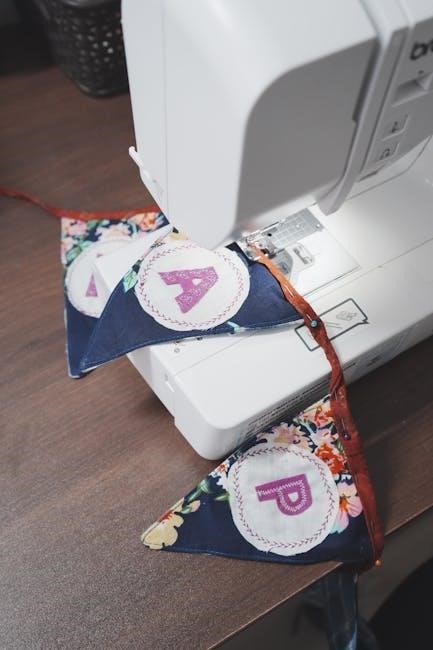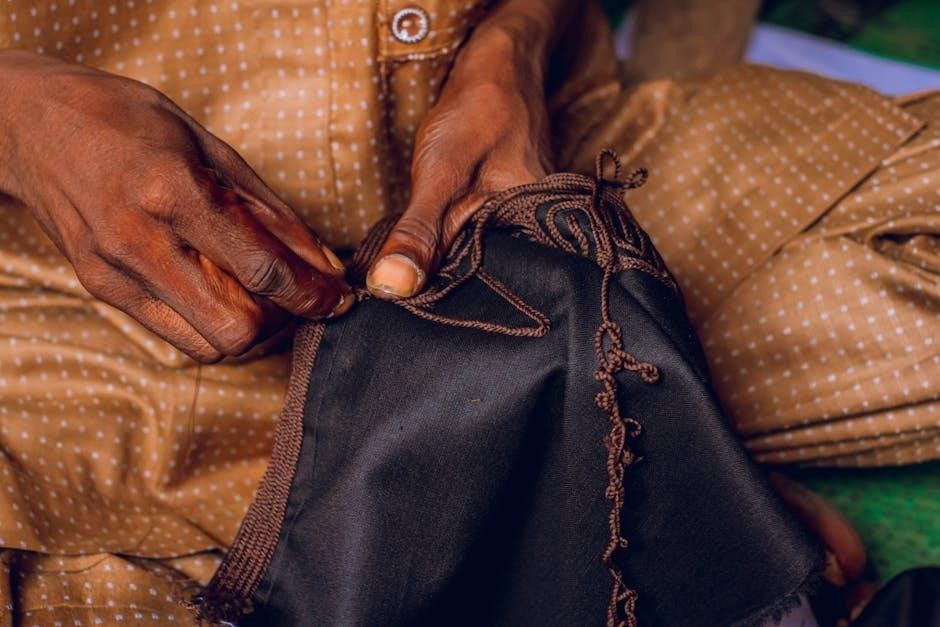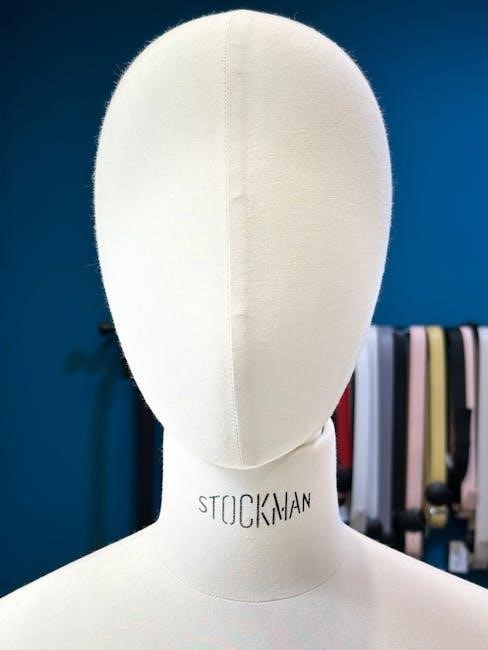Tailoring in Dragonflight is a versatile profession enabling players to craft armor‚ bags‚ and specialized gear. It plays a key role in both personal progression and the in-game economy‚ with Azureweave and Chronocloth being essential materials. The profession has seen significant updates‚ including cooldown-based crafting and resource management optimizations‚ making it a valuable skill for both new and experienced players.
1.1 What is Tailoring in World of Warcraft?
Tailoring is a crafting profession in World of Warcraft that allows players to create cloth items such as armor‚ bags‚ and other gear. It is one of the most versatile professions‚ particularly beneficial for classes that wear cloth or leather armor. Tailors can craft a wide variety of items‚ from basic clothing to high-end raid gear. This profession is also essential for creating specialty items like spellthread and bags‚ which are highly sought after by players. Tailoring complements other crafting professions and plays a key role in the game’s economy.
1.2 Importance of Tailoring in Dragonflight
Tailoring is a vital profession in Dragonflight‚ offering unique benefits for both players and their characters. It allows crafting of essential items like cloth armor‚ which is crucial for cloth-wearing classes such as Mages and Priests. Additionally‚ Tailors can create specialty items like spellthread‚ which enhances gear performance‚ and bags‚ increasing inventory space. This profession also supports other crafts‚ making it a cornerstone of character progression and the in-game economy. Its versatility ensures Tailoring remains highly relevant in Dragonflight.
1.3 Best Races for Tailoring in Dragonflight
Choosing the right race for Tailoring in Dragonflight can provide slight advantages. Blood Elves are popular due to their Arcane Affinity‚ boosting spellcasting‚ which can benefit spellcaster classes. Humans gain reputation bonuses through Diplomacy‚ aiding in recipe unlocks. Gnomes offer utility with Engineering synergies‚ though not directly tied to Tailoring. While no race provides a direct Tailoring bonus‚ Blood Elves and Humans are often favored for their indirect benefits. Ultimately‚ any race can excel with proper dedication and resource management.

Getting Started with Tailoring in Dragonflight
Tailoring in Dragonflight allows players to craft various gear and items essential for characters. Getting started involves learning the profession and gathering necessary materials.
2.1 How to Learn Tailoring
To learn Tailoring in Dragonflight‚ players must find a Tailoring trainer in major cities like Stormwind or Orgrimmar. These trainers teach the profession and its basics. The cost is minimal‚ and once learned‚ Tailoring is bound to the character. New players start with basic recipes for cloth goods‚ allowing them to craft simple items immediately. Ensure you have enough gold for training and initial materials like bolts of linen and threads to begin crafting.
2.2 Choosing the Right Specialization
In Dragonflight‚ Tailoring offers three specializations: Azureweaving‚ Chronocloth‚ and general Tailoring. Azureweaving focuses on crafting high-end cloth and bags‚ ideal for endgame crafting. Chronocloth specializes in creating powerful gear for PvE‚ particularly for healers and casters. The general Tailoring path provides versatility‚ allowing you to craft a wide range of items‚ including bags‚ gear‚ and specialty items. Choose a specialization based on your playstyle and goals‚ whether it’s raiding‚ making gold‚ or supporting your guildmates with essential items.
2.3 Starting Gear and Tools
To begin Tailoring in Dragonflight‚ you’ll need a Sewing Kit‚ which is essential for crafting. Start with basic bags‚ such as linen or woolen bags‚ as they provide ample storage for materials. Equip a simple weapon‚ like a dagger‚ to complement your Tailoring activities. Gather initial materials like cloth‚ threads‚ and dyes from vendors or the Auction House. While these tools may seem basic‚ they form the foundation for advancing your Tailoring skills and crafting better items as you progress.

Leveling Your Tailoring Skill
Leveling Tailoring in Dragonflight involves crafting items from raw materials‚ focusing on efficiency and recipe choices to maximize skill gains. Always use appropriate materials for your level to avoid wastage and ensure steady progression. Keep an eye on “orange” recipes‚ as they provide guaranteed skill-ups‚ while “yellow” and “green” recipes become less reliable as you progress. Crafting higher-tier items or specialization-specific gear can also accelerate your skill growth.
3.1 Leveling from 1 to 100
Leveling Tailoring from 1 to 100 in Dragonflight requires a strategic approach to maximize efficiency. Start by crafting basic items like Woolen Bolts and Linen Shirts using easily accessible materials. As you progress‚ transition to higher-tier fabrics like Silk and Mageweave. Always prioritize “orange” recipes‚ as they guarantee skill-ups. Crafting specialization-specific items can also provide consistent gains. Use vendor recipes or patterns learned from trainers to avoid reliance on rare materials. Plan your crafting route to minimize material waste and ensure a smooth progression to 100.
3.2 Best Recipes for Leveling
Selecting the right recipes is crucial for efficient Tailoring progression. Focus on crafting items with high material efficiency and consistent skill gains. Recipes like Woolen Bolts and Linen Shirts are excellent for early levels due to their simplicity and accessibility. As you advance‚ switch to Silk Bandages and Mageweave Cloths‚ which provide steady skill-ups. These recipes minimize material waste and ensure a smooth progression‚ avoiding the need for rare or hard-to-find components. Prioritize crafting items that align with your specialization to optimize skill gains and resource usage.
3.3 The Importance of “Orange” Recipes
“Orange” recipes in Tailoring are those that still have a chance to grant a skill-up‚ making them essential for efficient leveling. These recipes are cost-effective and provide consistent progress. Focus on crafting orange items‚ as they offer better skill gains compared to green or gray recipes. Prioritize crafting in bulk to minimize material waste. As your skill increases‚ the number of orange recipes decreases‚ so use them wisely to avoid unnecessary material costs and ensure steady progression through the levels. This approach maximizes efficiency and reduces downtime.
3.4 Leveling on Multiple Alts
Leveling Tailoring on multiple alts can be efficient by sharing materials and coordinating crafting needs. Start by equipping alts with Heirloom gear to boost experience gains. Use the auction house to transfer materials between characters. Focus on crafting high-demand items like bags or armor to generate income. Coordinate leveling schedules to avoid material shortages. Utilize class-specific bonuses if available. This approach saves time and resources‚ ensuring each alt reaches max level efficiently while maintaining a steady supply of crafting materials. Proper planning is key to success.

Crafting in Tailoring
Crafting in Tailoring involves creating items using materials and cooldowns. It allows players to craft gear‚ bags‚ and specialized items‚ enhancing gameplay and providing essential resources.
4.1 Crafting Basics
Crafting in Tailoring begins with opening the profession window and selecting a recipe. Players can craft items like cloth‚ armor‚ and bags using gathered materials. To start‚ ensure you have the required materials and reagents. Click on the recipe‚ and the crafting process will begin. Each craft consumes resources and may require multiple attempts to produce a high-quality item. Understanding the basics ensures efficient crafting and resource management.
4.2 Crafting Cooldowns
Crafting cooldowns in Tailoring are time-based restrictions on crafting certain high-quality items. These cooldowns reset daily‚ allowing players to craft limited quantities of premium gear. Understanding cooldowns is crucial for managing production and meeting demand. Focus on crafting high-demand items during cooldowns to maximize efficiency. This system encourages strategic planning and ensures a balanced economy. Always check your cooldown list to optimize crafting schedules and maintain productivity.
4.3 Crafting Azureweave and Chronocloth
Azureweave and Chronocloth are rare‚ high-end materials crafted through Tailoring. These cloths are essential for creating epic gear and are highly sought after by players. Crafting them requires rare threads‚ such as Imbued Thread and Temporal Pigment‚ which can be challenging to obtain. Each cloth type has unique properties‚ with Azureweave granting stamina and Chronocloth providing haste. These materials are in high demand‚ making them valuable for crafters aiming to produce top-tier equipment.
Plan your crafting schedule carefully‚ as creating these cloths can be time-consuming. Use cooldowns effectively to maximize production. Crafting Azureweave and Chronocloth is a great way to enhance your reputation as a skilled Tailor and meet the demand for premium gear in the market.

Managing Materials and Resources
Effectively managing materials is crucial for efficient Tailoring. Keep track of cloth‚ threads‚ and dyes‚ ensuring you have enough stock for crafting projects. Regularly clean up your inventory to avoid clutter and make space for new resources. Use bank slots or crafting bags to organize supplies. Plan ahead to avoid shortages and optimize crafting sessions. Efficient resource management saves time and enhances productivity.
5.1 Essential Reagents
Tailoring in Dragonflight requires specific reagents to craft items effectively. Cloth‚ threads‚ and dyes are the foundation‚ with higher-level recipes needing rare materials like Primal Focus or Dragon Isles resources. Keep a steady supply of Bolts of Cloth and Thread for basic crafts. Rare reagents like Chromatic Thread or Azureweave are essential for specialized items. Organize these materials in your bank or guild bank to streamline crafting. Regularly restock to avoid delays and ensure smooth progression in your Tailoring journey.
5.2 Farming Materials
Farming materials is crucial for Tailoring in Dragonflight. Focus on gathering cloth‚ such as Silk Cloth or Mageweave Cloth‚ from humanoid mobs in zones like the Waking Shores or Ohn’ahran Plains. Use your Tailoring skill to Scrap Cloth for additional resources. Herbalism and Skinning can also provide materials like threads or leather for crafting. Farming during off-peak hours or using a gatherer’s addon can maximize efficiency. Always prioritize materials needed for your current recipes to avoid waste and save time.
5.3 Storing and Organizing Materials
Properly storing and organizing materials is essential for efficient Tailoring. Use bank slots‚ guild banks‚ or void storage to keep items accessible. Consider using addons like Banker or Bagnon for better management. Organize materials by type or purpose‚ such as separating cloth‚ threads‚ and dyes. Utilize crafting bags like the Hexweave Bag for extra space. Regularly clean up your inventory to avoid clutter and ensure you can quickly find what you need for crafting.

Crafting Gear and Equipment
Tailoring enables the creation of versatile gear‚ such as armor sets‚ bags‚ and specialized equipment‚ catering to player needs and market demand effectively.
6.1 Crafting Armor
Crafting armor is a core aspect of Tailoring‚ allowing players to create versatile gear for themselves or others. In Dragonflight‚ Tailors can craft cloth‚ leather‚ and mail armor pieces‚ each tailored to specific classes. These armors often feature unique stats‚ making them ideal for different playstyles. Crafting armor requires specific cloth materials‚ such as Shadowy Cloth or Lightless Silk‚ which can be obtained from enemy drops or crafted using lower-tier materials. High-quality armors also incorporate additional components like threads or enchants‚ enhancing their effectiveness. Crafting armor is not only beneficial for personal use but also for selling or equipping alts‚ making it a valuable skill in the game economy.
6.2 Crafting Bags and Storage Items
Crafting bags and storage items is a vital part of Tailoring‚ providing essential inventory management tools. In Dragonflight‚ Tailors can create a variety of bags‚ from small‚ medium‚ and large cloth bags to specialized storage items. These items are highly sought after by players to expand their inventory space. Crafting bags requires cloth materials like Lightless Silk or Shadowy Cloth‚ along with threads and other reagents. High-quality bags can also be enchanted for additional functionality. Crafting storage items not only aids personal organization but also offers a profitable market for Tailors.
6.3 Crafting Specialized Gear
Crafting specialized gear in Tailoring allows players to create unique items with specific properties. These include cloaks‚ belts‚ and armor with specialized stats or effects. High-end recipes often require rare materials like Enchanted Thread or Twilight Cloth. Specialized gear is particularly valuable for certain classes or playstyles‚ offering enhanced performance in raids or dungeons. Crafting these items also opens up opportunities for enchanting‚ further boosting their utility. Specialized gear is a key part of a Tailor’s crafting repertoire and highly sought after by players.

Tailoring Specializations
Tailoring Specializations in Dragonflight allow players to focus on crafting specific types of gear‚ enhancing efficiency and catering to market demand. Choose wisely for optimal results.
7.1 Overview of Specializations
Tailoring Specializations in Dragonflight enable players to master specific crafting paths‚ such as creating magical fabrics or focusing on particular gear types. These specializations enhance crafting efficiency and cater to different playstyles. Azureweave and Chronocloth are prominent options‚ offering unique bonuses and item crafting opportunities. Players can choose specializations based on their goals‚ whether crafting high-demand gear or optimizing for profit. Specializations also influence material usage and cooldowns‚ making them a key aspect of advancing in Tailoring. Understanding each specialization’s strengths is crucial for success.
7.2 Best Specializations for Crafting
In Dragonflight‚ the best Tailoring specializations for crafting are those that align with your goals and playstyle. Azureweave and Chronocloth are highly sought after for their ability to craft high-end gear and materials. Specializations like Spellfire and Mooncloth also offer unique crafting opportunities. Choosing a specialization that complements your crafting needs ensures efficiency and maximizes output. Experiment with different paths to find what works best for you and your crafting objectives.
7.3 Advanced Specialization Builds
Advanced Tailoring builds in Dragonflight focus on optimizing specialization combinations for maximum efficiency. Players can combine specializations like Azureweave and Chronocloth to craft high-end gear and materials. Experimenting with hybrid builds allows for versatile crafting‚ while focusing on a single specialization can enhance mastery of specific item types. Advanced builds often incorporate complementary professions‚ such as Enchanting or Leatherworking‚ to create powerful gear sets. Tailors can refine their builds by testing different combinations and adapting to their playstyle and market demands.
Optimizing Your Tailoring Workflow
Optimizing your Tailoring workflow involves prioritizing tasks‚ using addons like GatherMate for material farming‚ and setting up a daily crafting routine to maximize efficiency and reduce downtime.
8.1 Time-Saving Tips
Plan your crafting sessions in advance to minimize downtime. Use addons like GatherMate for efficient material farming and Auction House addons for quick market checks. Organize your materials in bank tabs and bags for easy access. Prioritize crafting high-demand items during cooldowns to maximize efficiency. Keep a checklist of required materials and craft in bulk to reduce trip time. Set a daily routine for crafting and farming to maintain consistency. Use alts to gather materials or craft items while your main character rests.
8.2 Optimizing Crafting Routes
Plan efficient material-gathering routes in Dragonflight zones to reduce travel time. Use mounts or teleportation spells to quickly move between locations. Set up a crafting station near a bank or vendor for easy access. Prioritize crafting orders based on material availability and demand. Use in-game maps to identify resource-rich areas and avoid crowded spots. Organize your crafting queue to minimize downtime between crafts. Utilize alts to spread out crafting tasks and optimize your overall workflow.
8.3 Avoiding Common Mistakes
Avoid common mistakes like crafting without enough materials or ignoring recipe requirements. Double-check material counts before starting crafts. Don’t overlook specialization bonuses that boost efficiency. Ensure your crafting station is stocked with necessary tools. Avoid crafting low-demand items for profit. Don’t neglect to restock reagents like thread. Steer clear of crafting on low-level alts without proper skill levels. Avoid ignoring cooldowns for high-demand items. Plan ahead to prevent material shortages and wasted time.

Making Gold with Tailoring
Understand market trends‚ craft high-demand items like bags and equipment‚ and utilize cooldowns effectively to maximize gold income with Tailoring in Dragonflight.
9.1 Understanding the Market
Understanding the market is crucial for making gold with Tailoring. Research supply and demand on your server‚ focusing on high-demand items like bags‚ armor‚ and specialized gear. Analyze prices of materials and crafted goods to identify profitable opportunities. Use tools like The Undermine Journal to track market trends and competitor pricing. Timing your auctions strategically‚ such as during peak raid or PvP hours‚ can maximize sales. Tailor your crafting focus to what the market needs most‚ ensuring consistent demand for your products.
9.2 Crafting for Profit
Crafting for profit in Tailoring requires focusing on high-demand items like bags‚ shirts‚ and specialized gear. Analyze material costs and crafting times to ensure profitability. Use The Undermine Journal to identify market gaps and price trends. Mass-produce items like Mooncloth or Spellcloth bags‚ as they remain popular. Craft specialized gear during content lulls when demand spikes. Stagger crafting cooldowns to maximize efficiency. Balance crafting high-quality items with lower-cost alternatives to appeal to a broader market. Consistency and adaptability are key to long-term profitability.
9.3 Setting Up Your Tailoring Business
Setting up your Tailoring business involves creating a solid foundation for sales. Start by identifying your target market‚ such as raiders‚ casual players‚ or crafters. Invest in crafting high-demand items like bags and specialized gear. Use the auction house and trade chat to advertise your goods. Consider bulk listing items at competitive prices to attract buyers. Regularly restock popular items and monitor profits to reinvest in materials. Building a reputation as a reliable crafter will help grow your customer base over time.

Community Resources and Guides
Utilize platforms like Icy Veins and Wowhead for comprehensive guides. Join Discord communities and forums for tips. tools like The Undermine Journal aid in pricing and trends.
10.1 Recommended Websites
For mastering tailoring in Dragonflight‚ visit Wowhead for detailed guides‚ recipes‚ and materials. Icy Veins offers optimized crafting routes and gold-making strategies. The Undermine Journal provides market insights to maximize profits. Reddit’s WoW Economy community shares tips and trends. YouTube channels like Wowhead and Asmongold offer video tutorials and in-depth analysis. These resources ensure you stay updated and efficient in your tailoring journey.
10.2 Community Tips and Tricks
Experienced tailors recommend using addons like TradeSkillMaster to streamline crafting. Focus on crafting items with high demand‚ such as bags and cloth armor. Use cooldowns like Call to Arms to boost production. Farm materials during off-peak hours for less competition. Craft in bulk to minimize cooldown waste. Join guilds or communities for shared resources and market insights. Prioritize “orange” recipes for skill gains and efficiency. Track market trends to avoid oversupplying. These tips maximize productivity and profitability.
10.3 Joining Tailoring Communities
Joining tailoring communities enhances your crafting journey. Platforms like the official WoW forums‚ Reddit‚ and Discord offer vibrant groups. The r/WoW and r/TailoringGuide communities share valuable insights. Discord servers like Cloth Crafters provide real-time advice and resources. Engage with these groups to learn from experienced tailors‚ discover new techniques‚ and stay updated on market trends. Participating in community events or giveaways can also reward you with materials or crafted items. Active involvement fosters collaboration and mutual growth.

Staying Updated with Tailoring in Dragonflight
Stay updated with Dragonflight tailoring by checking official patch notes‚ community forums‚ and social media. Regularly review updates to adapt to new changes and improvements.
11.1 Checking for Updates
Regularly check Blizzard’s official website and World of Warcraft forums for updates on tailoring. Subscribe to community hubs like Reddit or Discord for real-time news; Follow social media channels dedicated to WoW for patch notes and balance changes. Tailoring updates often coincide with expansion patches‚ so stay vigilant during major content drops. Set up Google Alerts for “Dragonflight tailoring updates” to stay informed. Join Discord servers for WoW professionals to get firsthand information.
11.2 Following Tailoring News
Stay informed about tailoring updates by following Blizzard’s official patch notes and community-driven resources. Websites like Wowhead and IBC provide detailed breakdowns of changes. Join Discord communities dedicated to WoW professions for real-time discussions. Reddit forums and YouTube channels often highlight tailoring news. Set up news alerts for keywords like “Dragonflight tailoring” to catch updates quickly. Bookmark WoW news sites for consistent coverage on profession changes and trends.
11.3 Preparing for Future Content
Prepare for upcoming content by stockpiling materials and staying flexible with your crafted gear. Monitor Blizzard’s content roadmap to anticipate new patterns or changes. Experiment with current recipes to refine your skills and adapt to future updates. Keep an eye on beta releases for tailoring adjustments. Stay engaged with the community to share insights and strategies. By staying proactive‚ you’ll be ready to craft optimal gear for new challenges‚ ensuring your tailoring skills remain relevant in Dragonflight’s evolving landscape.
